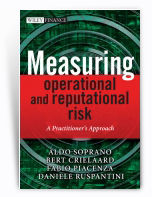| |||||
• polskie
• Zamów informacje o nowościach z wybranego tematu • kontakt |
MEASURING OPERATIONAL AND REPUTATIONAL RISK: A PRACTITIONER'S APPROACHSOPRANO A. CRIELAARD B. PIACENZA F. RUSPANTINI D.wydawnictwo: WILEY, 2009, wydanie Icena netto: How to apply operational risk theory to real-life banking data ALDO SOPRANO is Managing Director, UniCredit Basel 2 project manager for Central and Eastern European countries. Previously he was Group Head of Operational Risk Management. A Graduate in Economics, he holds a Master in Finance. In his career he has also been responsible for market risk management, credit risk control, capital allocation and more recently Chief Risk Officer of UniCredit Kazakhstan. He is the author of several articles on risk management and was the Chairman of the International Institute of Finance’s Working Group on Operational Risk. BERT CRIELAARD works in the Operational Risk Department of UniCredit (Holding) and is group-wide responsible for operational risk management in the Corporate, Private Banking and Asset Management business divisions. Previously he worked in the insurance and asset management industry in Italy and the Netherlands. He is (co-)author of articles on insurance in risk management. FABIO PIACENZA is a senior quantitative analyst at UniCredit Group Operational Risk Management in Milan. Graduated in mathematics, he is author of several articles on operational risk related topics. DANIELE RUSPANTINI works in UniCredit Group Milan in the Operational Risk Management team, graduated in mathematics, he is co author of articles on quantitative risk management. Table of Contents
Foreword (Andrea Sironi). Preface. Acknowledgments. 1 The Development of ORM in UniCredit Group. 1.1 A brief history of a fast-growing group. 1.2 Creating a new function. 1.3 Developing the new control system. 1.4 Challenges in the early stages. 1.5 Methodology to measure operational risk. 1.6 Training and internal communication focus. 1.7 International regulatory challenges. 1.8 Reputational risk management. 2 The Calculation Dataset. 2.1 Definitions. 2.2 Rules of thumb. 2.3 Internal loss data. 2.3.1 Business line mapping. 2.3.2 Event type classifications. 2.3.3 Data quality analysis. 2.3.4 Special cases. 2.4 Minimum loss threshold. 2.5 External data. 2.5.1 Public or external data sources. 2.5.2 Consortium data. 2.5.3 Scenario data. 2.6 Business environment and internal control factors. 2.7 Scenarios. 2.8 Insurance information. 2.9 Scaling data. 2.10 The Unicredit Group Operational Risk database Evolution. 2.11 Final considerations. 3 Loss Distribution Approaches. 3.1 Calculation dataset building. 3.1.1 Internal calculation dataset. 3.1.2 External calculation dataset. 3.1.3 Scenario-generated calculation dataset. 3.1.4 Risk indicators calculation dataset. 3.2 General LDA framework. 3.3 Operational risk classes. 3.3.1 Identically distributed risk classes. 3.3.2 Inflation adjustment. 3.3.3 Data independence. 3.4 Parametric estimation and goodness-of-fit Techniques. 3.4.1 Severity distributions. 3.4.2 Graphical methods. 3.4.3 Analytical methods. 3.4.4 Frequency distributions. 3.5 Applying extreme value theory. 3.6 g-and-h distribution theory. 3.7 Calculating operational capital at risk. 3.7.1 Loss severity distribution. 3.7.2 Loss frequency distribution. 3.7.3 Annual loss distribution. 3.7.4 Single class capital at risk. 3.8 Insurance modeling. 3.8.1 Appropriate haircuts reflecting the policy’s declining residual term. 3.8.2 Payment uncertainty. 3.8.3 Counterparty risk. 3.8.4 Application of insurance. 3.9 Adjustment for risk indicators. 3.10 Operational risk classes aggregation. 3.10.1 Copulae functions. 3.10.2 Elliptical copulae. 3.10.3 Archimedean copulae. 3.10.4 Choice of copula. 3.10.5 Correlation coefficients. 3.11 The closed-form approximation for OpVaR. 3.11.1 Effect of the minimum threshold on capital at risk. 3.12 Confidence band for capital at risk. 3.13 Stress testing. 3.14 Loss data minimum threshold setting. 3.15 Empirical application on Algo OpData. 3.15.1 Descriptive statistics. 3.15.2 Autocorrelation analysis. 3.15.3 Capital at risk estimates using parametric models. 3.15.4 Capital at risk estimates using EVT. 3.15.5 Capital at risk estimates using the g-and-h distribution. 3.15.6 Capital at risk estimates considering Correlation. 3.16 Regulatory capital requirement. 3.16.1 The consolidated capital requirement. 3.16.2 The individual capital requirement. 3.17 Economic capital requirement. 3.18 Integration of operational risk in the budgeting process. 4 Analyzing Insurance Policies. 4.1 Insurance management and risk transfer. 4.2 Qualifying criteria in the Basel 2 capital Framework. 4.2.1 Rating of the insurance company. 4.2.2 Duration and residual term of the insurance contract. 4.2.3 Policy termination requisites. 4.2.4 Claims reimbursement uncertainty and ineffective coverage. 4.2.5 Conclusions. 4.3 A practical application to traditional insurance. 4.3.1 Insurance policies to cover financial institutions’ operational risks. 4.3.2 Operational event types and available insurance coverage. 5 Managing Reputational Risk. 5.1 Introducing reputational risk. 5.2 A financial institution’s reputational risk exposure. 5.3 Managing reputational risk: a matter of policy. 5.4 Reputational risk measurement. 5.4.1 Reputational risk as a function of share price volatility. 5.4.2 Measuring reputational risk using scenarios. 5.4.3 Scoring-card-based models for reputational risk assessment. 5.5 A recent example of reputational event. 5.5.1 A description of the event. 5.5.2 Background. 5.5.3 How the fake trading occurred. 5.5.4 The discovery and first reactions. 5.5.5 Measures planned and taken. 5.5.6 Immediate consequences for SocGen. 5.5.7 Reputational issues and comments. 5.5.8 The lessons learned – what can we do to avoid being next? 5.5.9 Psychological, ‘soft’ factors. 5.5.10 Control instruments. 5.5.11 Managing data and signals. 6 Conclusions. References. Further reading. Index. 226 pages, Hardcover Księgarnia nie działa. Nie odpowiadamy na pytania i nie realizujemy zamówien. Do odwolania !. |


